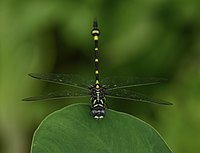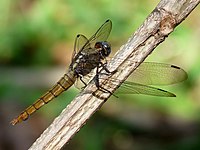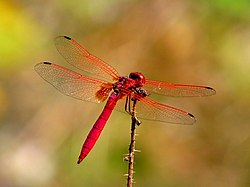Dragonflies & Damselflies
Phylum: Arthropoda
Class: Insecta
Order: Odonata.
Dragonflies are predators. The larvae inhabit water and adults fly near aquatic places. They are diverse in color and shape. There are major 2 types of odonates in the world; they are dragonflies and damselflies. The eyes are closer together in dragonflies, and their wings are held broadly opened from the body. They are robust in nature. In contrast, damselflies are delicately built small odonates, with well separated compound eyes. During rest, they do not expand their wings; the wings are folded over the abdomen or slightly spread.
Damselflies are categorized in to Suborder: Zygoptera; and dragonflies into Suborder: Anisoptera. 131 described species within 13 families can be found in Sri Lanka, with three new species in 2016. [1] [2]
The 65 endemic species and marked with an asterisk (*).
Suborder: Zygoptera - Damselflies
Damselflies are insect s of suborder Zygoptera in the order Odonata. They are similar to dragonflies, which constitute the other odonatan suborder, Anisoptera, but are smaller, have slimmer bodies, and most species fold the wings along the body when at rest. An ancient group, damselflies have existed since at least the Lower Permian, and are found on every continent except Antarctica.
All damselflies are predatory; both nymphs and adults eat other insects. The nymphs are aquatic, with different species living in a variety of freshwater habitats including acid bogs, ponds, lakes and rivers. The nymphs moult repeatedly, at the last moult climbing out of the water to undergo metamorphosis. The skin splits down the back, they emerge and inflate their wings and abdomen to gain their adult form. Their presence on a body of water indicates that it is relatively unpolluted, but their dependence on freshwater makes them vulnerable to damage to their wetland habitats.
64 Damselfly species can be found in Sri Lanka.
Suborder: Anisoptera - Dragonflies.
A dragonfly is an insect belonging to the order Odonata, suborder Anisoptera (from Greek ἄνισος anisos "uneven" and πτερόν pteron, "wing", because the hindwing is broader than the forewing). Adult dragonflies are characterized by large multifaceted eyes, two pairs of strong transparent wings, sometimes with coloured patches and an elongated body. Dragonflies can be mistaken for the related group, damselflies (Zygoptera), which are similar in structure, though usually lighter in build; however, the wings of most dragonflies are held flat and away from the body, while damselflies hold the wings folded at rest, along or above the abdomen. Dragonflies are agile fliers, while damselflies have a weaker, fluttery flight. Many dragonflies have brilliant iridescent or metallic colours produced by structural coloration, making them conspicuous in flight. An adult dragonfly eye has nearly 24,000 ommatidia.
Dragonflies are predators, both in their aquatic larval stage, when they are known as nymphs or naiads, and as adults. Several years of their lives are spent as nymphs living in fresh water; the adults may be on the wing for just a few days or weeks. They are fast, agile fliers, sometimes migrating across oceans, and are often found near water.
There are 65 Dragonfly species can be found in Sri Lanka.
This page is based on this
Wikipedia article Text is available under the
CC BY-SA 4.0 license; additional terms may apply.
Images, videos and audio are available under their respective licenses.

















































































![Amber-winged Marsh Glider (Hydrobasileus croceus) female.,paanntt[?] prunt[?]. (43412314945).jpg](http://upload.wikimedia.org/wikipedia/commons/thumb/9/91/Amber-winged_Marsh_Glider_%28Hydrobasileus_croceus%29_female.%2C%E0%B4%AA%E0%B4%BE%E0%B4%A3%E0%B5%8D%E0%B4%9F%E0%B5%BB_%E0%B4%AA%E0%B4%B0%E0%B5%81%E0%B4%A8%E0%B5%8D%E0%B4%A4%E0%B5%BB._%2843412314945%29.jpg/250px-Amber-winged_Marsh_Glider_%28Hydrobasileus_croceus%29_female.%2C%E0%B4%AA%E0%B4%BE%E0%B4%A3%E0%B5%8D%E0%B4%9F%E0%B5%BB_%E0%B4%AA%E0%B4%B0%E0%B5%81%E0%B4%A8%E0%B5%8D%E0%B4%A4%E0%B5%BB._%2843412314945%29.jpg)









































![Black stream glider (Trithemis festiva) female. kaa[?]ttumpi. (36741083730).jpg](http://upload.wikimedia.org/wikipedia/commons/thumb/e/e9/Black_stream_glider_%28Trithemis_festiva%29_female._%E0%B4%95%E0%B4%BE%E0%B5%BC%E0%B4%A4%E0%B5%8D%E0%B4%A4%E0%B5%81%E0%B4%AE%E0%B5%8D%E0%B4%AA%E0%B4%BF._%2836741083730%29.jpg/200px-Black_stream_glider_%28Trithemis_festiva%29_female._%E0%B4%95%E0%B4%BE%E0%B5%BC%E0%B4%A4%E0%B5%8D%E0%B4%A4%E0%B5%81%E0%B4%AE%E0%B5%8D%E0%B4%AA%E0%B4%BF._%2836741083730%29.jpg)










